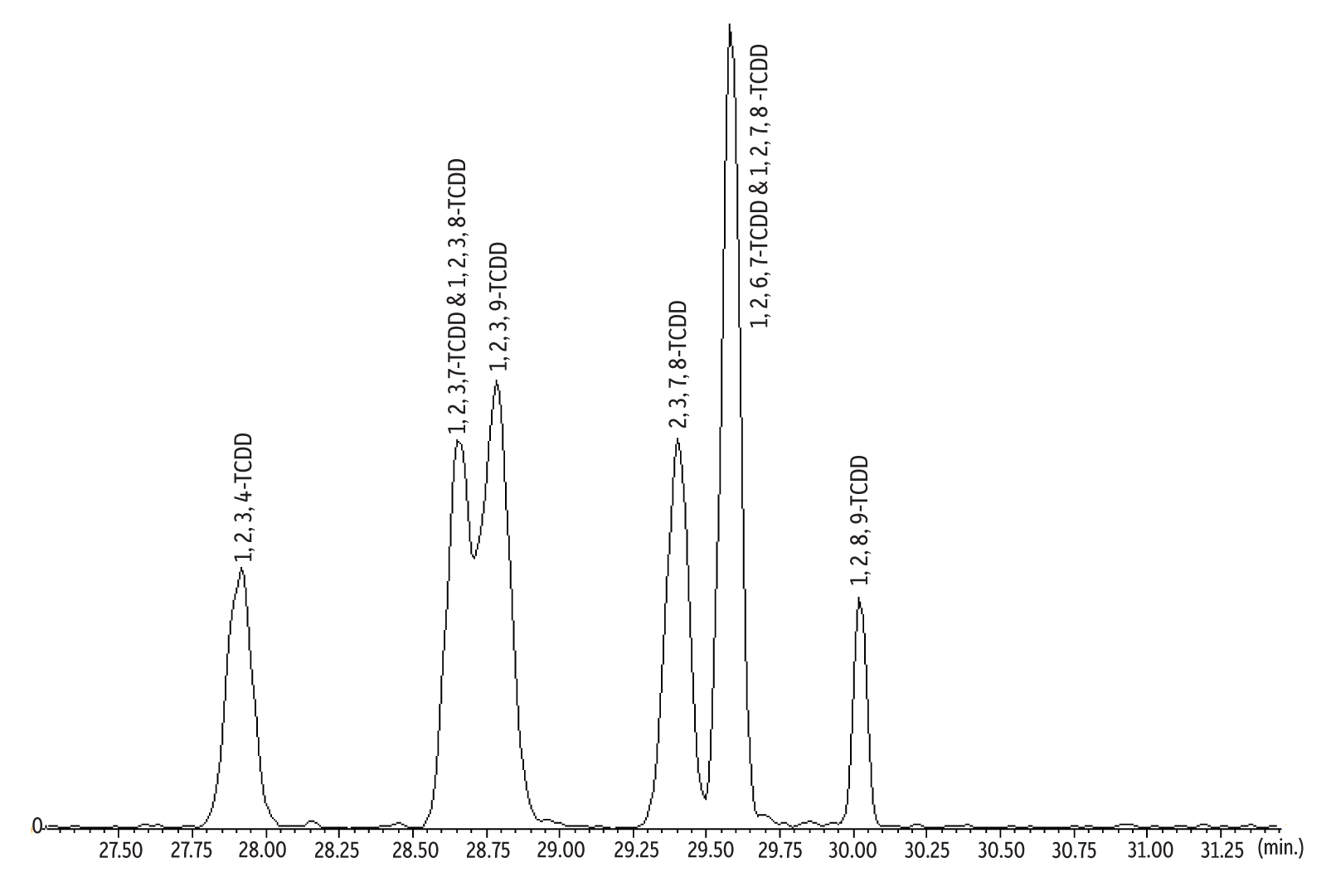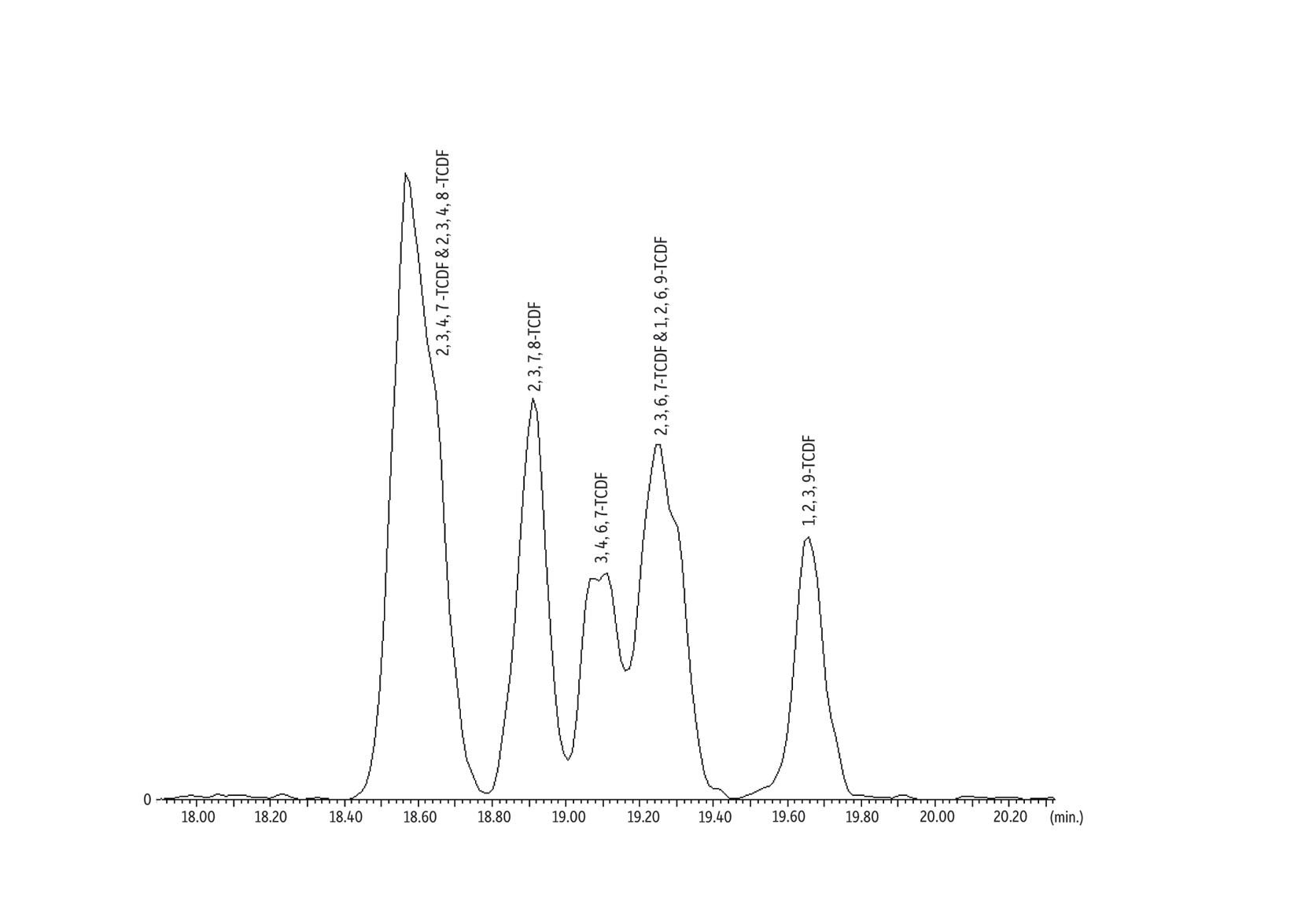Increase Productivity for Dioxin and Furan Analysis with Rtx-Dioxin2 GC Columns
- Increase Productivity for Dioxin and Furan Analysis with Rtx-Dioxin2 GC Columns
Isomer specificity for 2,3,7,8-TCDD and 2,3,7,8-TCDF provided with one column. - Higher temperature stability (340 °C) than other confirmation columns results in longer column lifetimes and greater accuracy and reproducibility.
- Customer lab receives award for increased productivity using Rtx-Dioxin2 columns.
Increase Productivity for Dioxin and Furan Analysis with Rtx-Dioxin2 GC Columns
Accurate GC determination of polychlorinated dibenzodioxin (PCDD) and polychlorinated dibenzofuran (PCDF) congeners is a challenge as even when using a high resolution mass spectrometer the separation of toxic congeners proves difficult on almost all stationary phases. Most labs address this by initially analyzing samples on a 5% diphenyl column and then using a cyano phase, such as a DB-225, SP-2330, or SP-2331 column, for confirmation. Cyano columns typically exhibit low thermal tolerance, resulting in long analysis times and phase bleed that can shorten column lifetimes and limit quantification levels.
Rtx-Dioxin2 columns have a much higher temperature stability compared to other confirmation columns and provide isomer specificity for both 2,3,7,8 substituted tetrachloro dioxins and furans (Figures 1 and 2). Thermal stability up to 340 °C allows faster analysis times and ensureslow bleed. Exceptional resolution of both 2,3,7,8-TCDF and 2,3,7,8-TCDD from other potentially interfering congeners improves accuracy and reduces the need for time-consuming resolution check calculations. As shown by Maxxam Analytics (see below), the excellent thermal stability and unique selectivity of the Rtx-Dioxin2 column can be used to significantly increase lab productivity.
Figure 1: TCDDs on an Rtx-Dioxin2 Column

| Peaks | tR (min) | |
|---|---|---|
| 1. | 1,2,3,4-TCDD | 27.92 |
| 2. | 1,2,3,7-TCDD | 28.65 |
| 3. | 1,2,3,8-TCDD | 28.65 |
| 4. | 1,2,3,9-TCDD | 28.78 |
| 5. | 2,3,7,8-TCDD | 29.40 |
| 6. | 1,2,6,7-TCDD | 29.58 |
| 7. | 1,2,7,8-TCDD | 29.58 |
| 8. | 1,2,8,9-TCDD | 30.02 |
| Column | Rtx-Dioxin2, 60 m, 0.25 mm ID, 0.25 µm (cat.# 10758) |
|---|---|
| Standard/Sample | Laboratory prepared test mix |
| Injection | |
| Inj. Vol.: | 1.0 µL splitless |
| Inj. Temp.: | 290 °C |
| Oven | |
| Oven Temp.: | 150 °C (hold 1 min) to 210 °C at 30 °C/min (hold 1 min) to 250 °C at 3 °C/min (hold 12 min) to 330 °C at 70 °C/min (hold 6 min) |
| Carrier Gas | He, constant flow |
| Flow Rate: | 1.5 mL/min |
| Detector | Micromass Autospec Ultima |
|---|---|
| Transfer Line Temp.: | 290 °C |
| Analyzer Type: | Magnetic Sector |
| Source Temp.: | 290 °C |
| Tune Type: | PFK |
| Ionization Mode: | EI |
| Instrument | Agilent/HP6890 GC |
| Acknowledgement | Courtesy of Maxxam Analytics (Ontario, Canada). |
Figure 2: TCDFs on an Rtx-Dioxin2 Column

| Peaks | tR (min) | |
|---|---|---|
| 1. | 2,3,4,7-TCDF | 18.58 |
| 2. | 2,3,4,8-TCDF | 18.58 |
| 3. | 2,3,7,8-TCDF | 18.91 |
| 4. | 3,4,6,7-TCDF | 19.10 |
| 5. | 2,3,6,7-TCDF | 19.24 |
| 6. | 1,2,6,9-TCDF | 19.24 |
| 7. | 1,2,3,9-TCDF | 19.66 |
| Column | Rtx-Dioxin2, 60 m, 0.25 mm ID, 0.25 µm (cat.# 10758) |
|---|---|
| Standard/Sample | Laboratory prepared test mix |
| Injection | |
| Inj. Vol.: | 1.0 µL splitless |
| Inj. Temp.: | 290 °C |
| Oven | |
| Oven Temp.: | 180 °C (hold 1 min) to 235 °C at 45 °C/min (hold 1 min) to 250 °C at 3 °C/min (hold 15 min) to 300 °C at 50 °C/min (hold 1 min) |
| Carrier Gas | He, constant flow |
| Flow Rate: | 1.7 mL/min |
| Detector | Micromass Autospec Ultima |
|---|---|
| Transfer Line Temp.: | 290 °C |
| Analyzer Type: | Magnetic Sector |
| Source Temp.: | 290 °C |
| Tune Type: | PFK |
| Ionization Mode: | EI |
| Instrument | Agilent/HP6890 GC |
| Acknowledgement | Courtesy of Maxxam Analytics (Ontario, Canada). |
A Customer’s Story…
Maxxam Analytics HRMS Group Receives Kaizen Award for Productivity Improvements
Maxxam Analytics presented a Kaizen award for productivity improvement to their High Resolution Mass Spectrometry Department at the Mississauga laboratory in Ontario. This award was presented in recognition of process improvements that the group made using an Rtx-Dioxin2 column for multiple methods, which resulted in increased instrument capacity.
The Mississauga lab gets many requests for analyzing drinking water samples for 2,3,7,8-TCDD only using EPA Method 1613. They had been analyzing these short-list samples on the same instrument used for full-list PCDD/PCDF and PCB congeners; however, this limited the number of the longer list analyses that could be performed on that instrument. Maxxam also confirms the presence of 2,3,7,8-TCDF using a different column installed on another instrument. Since the Rtx-Dioxin2 column provides isomer specificity for both 2,3,7,8-TCDD and 2,3,7,8-TCDF and has much greater temperature stability than cyano columns, chemists in the High Resolution Mass Spectrometry group explored using it for both the TCDD-only samples and the 2,3,7,8-TCDF confirmations.
By moving to an Rtx-Dioxin2 column (60 m x 0.25 mm x 0.25 μm, cat.# 10758) they were able to optimize the EPA 1613 drinking water TCDD-only analysis and reduce the run time from 50 minutes to 30 minutes, saving 20 minutes per analysis! EPA Method 1613 requires a minimum retention time for the labeled 1,2,3,4-TCDD of 25 minutes to meet method specifications for the recovery standard, so this was close to ideal. While the analysis time for the TCDF confirmation analysis was not significantly reduced, run cycle time was decreased by taking advantage of the column’s 340 °C thermal stability. This resulted in lower estimated detection limits and less column bleed compared to the columns that the lab had previously used. In addition, the higher maximum programmable temperature also allows analysts to use high temperature holds to reduce the potential for carryover contamination between samples.
Since the lab was able to run both the TCDD-only and TCDF confirmation analyses on the Rtx-Dioxin2 column, they were able to use the same instrument for both analyses, which allowed more full-list dioxin and PCB samples to be analyzed on the other instrument. According to Owen Cosby of Maxxam Analytics, “using the Rtx-Dioxin2 column allowed us to combine EPA 1613 TCDD-only and TCDF confirmation analyses onto one column and one instrument. This resulted in multiple benefits—we shortened run times,reduced instrument downtime and column changes, and increased instrument capacity for our full-list samples.” Congratulations to Maxxam Analytics’ Hi-Res Mass Spec Ultra Trace Analysis team, who received a Kaizen award for productivity improvements made using the Rtx-Dioxin2 column. Shown from left to right are Owen Cosby, Supervisor HRMS Services; Kay Shaw, HRMS Team Leader and Scientific Specialist; and Angel Guerrero, HRMS Senior Analyst.

